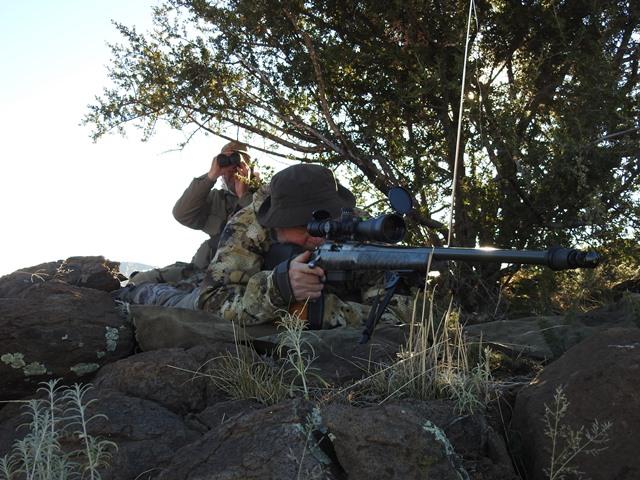Bird Hunting Hawaii: Immigrants from Nepal
by David Bryer
Hawaii is a popular vacation destination, and many have been fortunate to have xperienced one, or all the islands through big game fishing, snorkeling, diving, sunset cruise, sunbathing, kayaking and so many other adventures. With a multitude of choices, people don’t think to research the hunting opportunities available.

My wife and I (and kids) have traveled there several times, but our itinerary is usually different from most vacationers. Bird hunting is my passion and if a bird hunting adventure can be found, my wife claims I will find it. Surprisingly, the Hawaiian Islands offer many opportunities on the six main islands of Kaua’i, O’ahu, Maui, Moloka’i, Lana’i and Hawaii. Some of these islands are simply public areas with no guide service available. It is best to look on State of Hawaii’s Division of Forestry and Wildlife (DOFAW) website to educate yourself about each island’s possibilities.
Maui has excellent bird hunting behind pointing dogs and was my first experience hunting the Hawaiian Islands. Growing up in Nebraska where it can be miserably cold pheasant hunting, it was awesome hunting in shorts and a t-shirt through thick vegetation among the lava tubes. And after a great day hunting, what a treat to grill ringneck and blue pheasant by the beach at our condo.
In my research, I have read that Moloka’i has excellent guided bird hunting and I plan to experience that island one of these days. However, my wife and I love the Big Island (Hawaii) and it seems to be where we gravitate for a beach break. She is my buddy and comes along on my hunts to take photos, hike and explore. Getting up early to save a lounge chair by the pool pales in comparison to driving to a remote spot to meet our guide for the day.

We always look forward to getting away from the tourist parts of the islands and gain a completely different perspective of the topography, people, climates and scenery. We have hunted a couple of times before on Hawaii and I have harvested Japanese quail, valley quail, black francolin, Erkle’s francolin and blue pheasant on other ranches. On those previous trips, my goal was always a Kalij pheasant and I did see a couple of them soaring among the trees, but a decent shot never presented itself. Our most recent trip was opening day 2018, November 3. I’m always researching new places and read about Kealia Ranch, which boasted a high success rate. Of course I had to try again.
Most people are not familiar with the Kalij pheasant. In 1962 the Kalij pheasant, a native of Nepal, was released on the Big Island. They not only survived, they flourished. The Kalij pheasant, lophura leucomelana leucomelana, is limited to subtropical pine and moist temperate rainforest. The Hawaiian locals refer to them as the jungle pheasant. This is the only place in the world that you can hunt the Kalij.
Jon Sabati was our guide at Kealia Ranch. This is a working cattle ranch and is beautifully managed. The ranch is divided into paddocks and the cattle are rotated so while one paddock would looked almost manicured,

another was extremely overgrown. I was impressed that nothing was overgrazed, thus ensuring the entire ranch had great habitat. Just a heads up, this means a lot of gates to open! Jon has been with the ranch for many years and is a very knowledgeable hunting guide. He is passionate about Hawaii’s land, animals and the people who reside there. A native Hawaiian, Jon cares about his homeland and making sure the hunting tradition continues with good habitat and healthy populations of game. He is currently the president of the local Wild Turkey Federation, a chapter he started. We personally saw many turkeys, bulls and boar on the ranch where Rio Grande turkey, wild boar, mouflon, Vancouver bull, Black Hawaiian sheep and feral goats are hunted as well.
My wife found an Airbnb two blocks from downtown Kona. This turned out to be the perfect location to get on the main road to go hunting as well as an easy walk to downtown shops and restaurants.
The first morning we had a 10 to 15-minute drive to meet Jon at a McDonald’s along one of the main highways circling the island. Kealia Ranch is in the upper elevation almost directly above Kona. After following him to the ranch, he quickly took care of the license and loaded up the Toyota Tacoma to start uphill.

I can’t tell you how happy I was we didn’t have to hike those steep ranch roads. I have a new appreciation for the Tacoma! As we climbed, we went through a couple different climates. The first change of scenery was obvious, dense jungle habitat. The vegetation is so thick and damp that it is almost impossible to hike. As we crawled along on the road, we were looking into the jungle for Kalij. Unlike other hunts in Hawaii, dogs are not used. Most of the time Kalij are on the road and disappear into the jungle when they see the truck.
Jon’s trained eye spotted a couple of males just off the road. Getting out of the truck and ready to shoot without spooking the birds is very difficult. It was not easy to contain my excitement and be stealthy and just focus on the birds. The first male busted and I shot it, flushing the second, which I proceeded to miss.
Oh well, I finally had my Kalij. What a beautiful bird! I feel very fortunate to not only have seen them in the wild, but also have the opportunity to challenge my shotgun skills against such a formidable bird. They are smart and fly swiftly through dense forest. There are only quick windows of opportunity to make a shot between trees. I enjoy competing in sporting clays and FITASC and those hours spent practicing really pay off in a hunt like this.
After the jungle portion of our climb, the highest elevation is a drier climate with open grasslands broken up with groupings of trees.

We got out and hiked a bit. Jon and I flushed two groups of francolin and harvested two females. The male Erkle’s francolin are significantly larger than the females but look identical. Therefore, when they flush it is hard to distinguish. Fortunately, they have flourished so much in Hawaii that males and females are fair game.
Back in the truck we traversed the ranch roads, looking for birds, all the while having a view of the ocean. Seriously. You have to stop and really absorb the surroundings and let it sink in! It really is a new adventure pheasant hunting in Hawaii, walking on lava rock through thick vegetation, sudden rain, sunshine, cool, hot, ocean views and all of it can happen in an hour’s time.
The next day, Jon and I excitedly chatted about the hunt ahead, as we drove seemingly straight up. I’m not going to lie, it’s mostly just driving around trying to spot birds and at first I was disappointed. My wife and I were looking forward to hiking like in our past hunts. But when I saw the vegetation and tried walking a short distance, I was perfectly happy in the passenger seat and Eileen on her perch in the backseat. Once again Jon spotted hidden birds and I shot two more Kalij, a male and a female. I have to mention the difficulty finding the bird you just hit, watch it fall and think you know where it landed. With jungle vegetation, finding the harvested bird is as challenging as finding a live one. Watching Jon follow a trail of feathers to a dead bird in dense brush was amazing. He has serious tracking skills.
As we crept along the ranch roads, I replayed a great hunt in my head as the day was winding down. Assuming we are headed back toward our rental car, we realized Jon was determined that I would get my limit. Jon had complemented me several times on my shooting skills and felt I could be one of the few to limit out. Apparently, many times a hunter doesn’t get a limit, due to the inability to hit the quickly moving Kalij, not from lack of birds. Of course with a compliment like that, who’s going to call it a day? So, we continued. He was definitely not worried about getting back at exactly 5:00 and wanted make sure I had the best possible day hunting.

The ground is so uneven with lava rock and plants so thick that seeing these birds is actually surprising. When habitat is this fabulous, there is no question the amount of unseen birds is staggering. About an hour left in our hunting day and we were crawling along the ranch road. My wife had been quiet in the back seat taking photos and enjoying the scenery when she suddenly blurted out she saw a Kalij.
Claiming she noticed a red spot a couple feet off the road, she looked down as we drove by and there was a Kalij pheasant. Wait, what? Did she see something I missed? I glanced back and sure enough, in a hole next to a grass-covered lava rock he was watching us with his head ducked down. Nice catch! Jon continued up the road a bit so we didn’t spook him. We quietly got out of the Tacoma and quickly moved toward the bird’s location. It worked as he was still there, but busted out of hiding when he saw us walking back. I lined up my fading shot and filled my three-bird limit. This was an unmatched bird hunting experience.
These pheasants have thrived in the Big Island habitat. Jon explained that Kalij don’t congregate in large groups. They are territorial and spread out, which probably contributed to their success. They are smart and fast and pose a great challenge for all avid bird hunters. Hunting with a 20-gauge made it more challenging, but assured the birds were in perfect condition for taxidermy. Jon is an excellent hunting guide and host. We laughed a lot and learned much in our two days. I highly recommend a hunt and my wife concurs. I finally accomplished outsmarting the Kalij, but I’m afraid that instead of checking it off my list, I may be hooked. I’m guessing we will be back and Eileen agrees. After all, it’s Hawaii!









